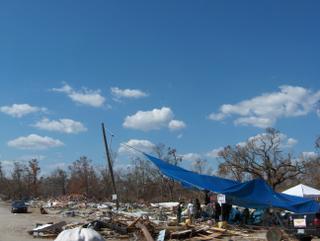City Hall
 Mike's a deputy with Rowan County sheriff. He was dispatched here shortly after the storm to assist with rescue and law enforcement. "Law enforcement and rescue is what I do. It's all I know." He looks like a character out of an action movie. His close cropped gray blond hair and tan sun wrinkled hair contrast with his intensely blue eyes. He offered to take me on a tour of the devastation in his four wheel drive truck. I'd seen pictures and listened to news reports, but they did not prepare me for what I saw. The nearer to the the beach front we drove, the more complete he devastation became.
Mike's a deputy with Rowan County sheriff. He was dispatched here shortly after the storm to assist with rescue and law enforcement. "Law enforcement and rescue is what I do. It's all I know." He looks like a character out of an action movie. His close cropped gray blond hair and tan sun wrinkled hair contrast with his intensely blue eyes. He offered to take me on a tour of the devastation in his four wheel drive truck. I'd seen pictures and listened to news reports, but they did not prepare me for what I saw. The nearer to the the beach front we drove, the more complete he devastation became. Initially, houses with blown out windows and damaged roofs, yards full of debris were interspersed with completely collapsed houses. A short distance closer to the beach, the walls of the houses were completely collapsed, frequently with the roof, relatively intact, lying a few yards away to the side. A few hundred yards closer to the ocean, there were only foundations and windrows of the detritus of shattered lives. There were no large pieces. The only identifiable items were toilets and sinks.
Ironies are everywhere. Town center a few miles back from the beach was a war zone. The only thing of substance still standing was a monument to the people of the town who rebuilt the town after Camille in 1969. Town hall was only a foundation. But over this foundation flew a blue tarp and a card table. It was now the center of relief distribution.
Early this morning I saw a middle aged woman whose chronic obstructive pulmonary disease was worse because she'd lost all of her medications. She told me an incredible story. "We thought we had it made when we survived the wind. But then the water began to rise. It rose so quick. My two daughters and I had to dive under water to go through a window and get out of the house. We pulled our two dogs with us. We all made it to the roof and survived, but we ain't got nothin' left.
She thanked me profusely when she left. It's almost always the same, incredible stories and profound gratitude.
Wes
